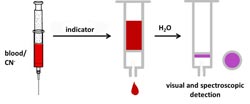Rapid response in cases of smoke poisoning

Two-step procedure to detect blood cyanide: 1) The chemosensor is added to the blood sample. If cyanide is present in the blood, it forms a purple complex with the chemosensor. The solution is squeezed through a syringe containing a solid phase. 2) The solid phase is rinsed with water to remove the blood, leaving the violet complex that the cyanide formed with the chemosensor.<br><br>Picture: UZH<br>
Because the quick diagnosis and treatment of victims with cyanide poisoning is critical and often lifesaving, it is very surprising that a cyanide test for emergency situations is not yet available. Now, chemists at the University of Zurich have developed a simple and reliable procedure to detect blood cyanide in less than two minutes.
The main cause of cyanide poisoning is smoke inhalation in closed spaces during fires. Cyanides, the salts of hydrocyanic acid, inhibit cellular respiration and may lead to coma or death. The rapid administration of a cyanide antidote is essential for successful treatment. Previously, detecting cyanide in the blood took up to an hour and could only be performed in the laboratory, a lengthy process that is poorly suited for emergency situations.
As a result, emergency doctors and paramedics are forced to administer antidotes based solely on presumptive diagnoses. Now, chemists at the University of Zurich have succeeded in detecting blood cyanide in less than two minutes and without any laboratory equipment: UZH chemists Christine Männel-Croisé and Felix Zelder combined a cyanide color test with an extraction method to produce results quickly and reliably.
The newly developed procedure works with only a tiny drop of blood mixed in a detection vial with a pH buffer, water, and a cobalt-based chemosensor. If the blood contains cyanide, the solid phase of the vial turns purple.
Faster, easier, more versatile
“What I like most about our method is that detection is possible solely with the naked eye, and it needs only a drop of blood,” says Zelder. Quantitative measurements are also possible, thereby enabling emergency responders to determine the grade of cyanide poisoning. The correct dosage of antidote can be chosen, and detoxification can be monitored during treatment. “In principle, our method meets all the requirements for application in emergency situations,” explains Christine Männel-Croisé. Currently, Männel-Croisé and Zelder are in discussion with paramedics to test their method in cases of emergency.
Further reading:
Christine Männel-Croisé and Felix Zelder. Anal. Methods, 2012, 4, 2632.
Contact:
Dr. Felix Zelder
Institute of Inorganic Chemistry
University of Zurich
Phone: +41 44 635 46 24
Eemail: zelder@aci.uzh.ch
Media Contact
More Information:
http://www.uzh.chAll latest news from the category: Life Sciences and Chemistry
Articles and reports from the Life Sciences and chemistry area deal with applied and basic research into modern biology, chemistry and human medicine.
Valuable information can be found on a range of life sciences fields including bacteriology, biochemistry, bionics, bioinformatics, biophysics, biotechnology, genetics, geobotany, human biology, marine biology, microbiology, molecular biology, cellular biology, zoology, bioinorganic chemistry, microchemistry and environmental chemistry.
Newest articles

Superradiant atoms could push the boundaries of how precisely time can be measured
Superradiant atoms can help us measure time more precisely than ever. In a new study, researchers from the University of Copenhagen present a new method for measuring the time interval,…

Ion thermoelectric conversion devices for near room temperature
The electrode sheet of the thermoelectric device consists of ionic hydrogel, which is sandwiched between the electrodes to form, and the Prussian blue on the electrode undergoes a redox reaction…

Zap Energy achieves 37-million-degree temperatures in a compact device
New publication reports record electron temperatures for a small-scale, sheared-flow-stabilized Z-pinch fusion device. In the nine decades since humans first produced fusion reactions, only a few fusion technologies have demonstrated…





















